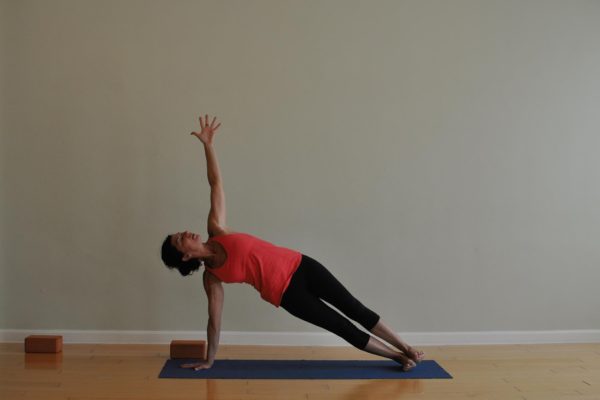
One of the important components of teaching yoga is offering modifications. A modification is generally an action that the student takes to change the posture from one shape to something different but along very similar lines. An example would be in a pose like a standing lunge, dropping the knee of the back leg to the floor. This begs the question: why offer modifications and when? (keep in mind this article is written from the perspective of the teacher but can apply to the student’s point of view also).
Let’s first look at some of the reasons why it might make sense as a teacher, to offer modifications:
- You’re teaching a class of beginners
- You notice a student or a few students having a hard time with the pose as presented
- You want to increase accessibility to the pose for all students
- You want to offer options to demonstrate the versatility of the pose
- You want to weave into your teaching the theme of modifying poses as a way to decrease the amount of effort expended in the practice (i.e. let’s say you’re teaching with the theme of “Taking Care of Yourself”)
- You’re working with a private student who is injured or have a student approach you before class with an injury
- You’re working with an older student with limited mobility
There are more reasons to offer modifications but that covers a number of them. So, now that we’ve looked at why you might offer modifications, let’s take a look at how and when to offer them:
One approach is to pepper them throughout your teaching, regardless of what you might see happening in the room. This approach can be helpful to advise students of other ways to take various poses, as students can be unaware of their options in certain postures.
Another approach (in group classes) is to suggest specific modifications if you see one or more students is struggling in a particular pose. For instance, in teaching Plank to Side Plank, if you see that a handful of students are experiencing the challenge of keeping the hips lifted, suggest dropping the knee under the hip.
A different approach comes with more experience teaching classes and can also be effective in that it anticipates a common problem that students might experience. Again, a good example of this is Plank to Side Plank. This approach simply suggests that you offer the modification regardless of what you see and that you make offering the modification part of teaching the pose. I like this approach because it makes the modification part of the sequencing versus making “teaching with modifications” something different than what you might teach otherwise.
There are a few other aspects around modifications that we should cover. The first is the concept of modifications as a way to “make the pose easier.” Sometimes students will hold off from modifying because they don’t want to appear to be a beginner and they may see other people doing the pose differently and want to do it the way others are doing it, simply out of a need to blend in with the group. That’s one reason it can be helpful to offer modifications as part of your teaching so that it just becomes part of the sequence rather than “something different.”
Another thing to consider is that as you deepen your understanding of anatomy, you can offer the anatomical reason to modify as a way to educate students as to why you’re suggesting it in the first place. A good example of this is suggesting use of a strap in a behind-the-back bind. This movement requires a good amount of length in the internal rotators of the shoulder; muscles like the subscapularis and teres major. If they’re shortened from lifting weights, cycling or just the day to day hunching over the desk, it can be hard for students to externally rotate their shoulders once they take the bind. Using a strap helps them get some additional length to help out these shortened muscles. I find that when I explain it to the class, I see a handful of people grab a strap or towel when before, they were not using one.
If you’re looking for an easy way to learn some of the anatomy associated with the postures, take my LEARN YOGA Challenge, a free video series on my You Tube channel. You can download the guide with links to the videos here.Â
I offer an entire section on modifications in my 200 page anatomy manual which is a companion guide to my online course on anatomy called “Your Yoga Anatomy Blueprint.” To check out the online course and find out more about how you can deepen your understanding of anatomy with this online resource (and earn CEUs) click here.Â
To read more about the Bare Bones Yoga Guide to Anatomy Manual, click here.
Both of these resources will help you increase your understanding of anatomy and can be a helpful supplement to in-person training.
As always, I welcome your comments!
